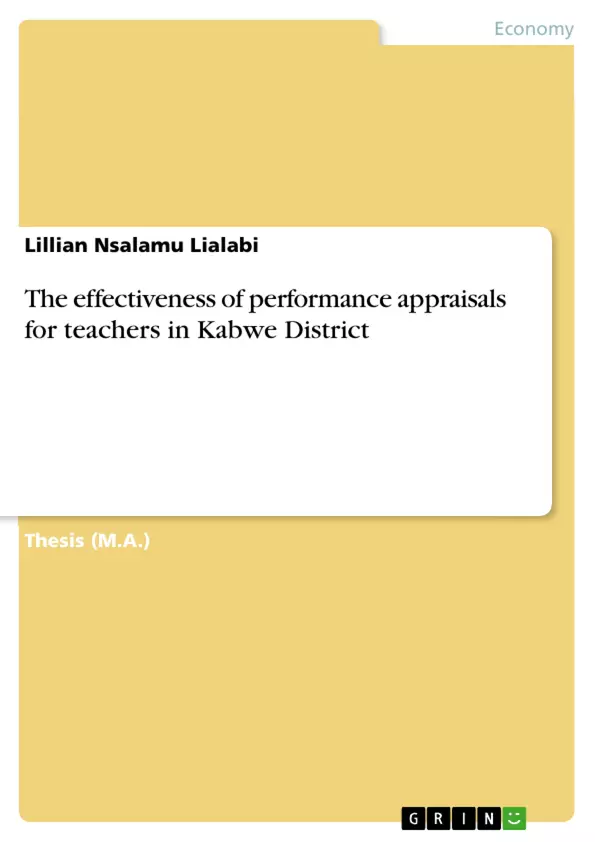The purpose of this quantitative and qualitative research was to assess the effectiveness of performance appraisals with regard to promotion in the Ministry of Education, Science, Vocational Training and Early Education in Kabwe District. There is a concern on how employees are rewarded by the way of promotion in the MOESVTEE in Kabwe District. Some teachers complain that, underserving teachers are those that get promoted at the expense of other hardworking teachers. The research used teacher’s effort, ability, role perception and performance as independent variables with promotion as the dependent variable.
A cross sectional survey, structured questionnaire, simple random sampling was used to collect the data and multiple regression was used to analyze the data using mega start. Data was collected from 123 head-teachers, deputy-teachers and teachers using a questionnaire survey. Data was analyzed into two stages firstly it was checked for validity, reliability, identification outliners and normality of the data. Secondly multiple regression was conducted to test the hypotheses.
Results from the survey indicate that, the Performance Appraisal system for teachers in Kabwe District is not effective. However, promotion practices were found to influence performance of teachers in the District. Teachers in the District have a negative perception on how promotions are carried out.
Inhaltsverzeichnis (Table of Contents)
- DEDICATION
- ACKNOWLEDGEMENTS
- TABLE OF CONTENTS
- LIST OF TABLES
- LIST OF FIGURES
- LIST OF ACRONYMS
- ABSTRACT
- CHAPTER ONE
- BACKGROUND OF THE RESEARCH
- 1.0 Introduction
- 1.1 Ministry of Education, Science, Vocational Training and Education (MOESVTEE) in Kabwe District
- 1.2 Statement of the problem
- 1.3 Research questions
- 1.4.0 Main objective of the research
- 1.4.1 Research specific objectives of the research
- 1.5 The scope of the research
- 1.6 The significance of the research
- 1.7 Key Concepts of the research
- 1.8. Outline of the chapters
- 1.9 Summary
- CHAPTER TWO
- LITERATURE REVIEW
- 2.0 Introduction
- 2.1 Promotions
- 2.1.1 Empirical Evidence on Promotions
- 2.2 Promotions as Incentives
- 2.2.1 Empirical Evidence of Promotion as Incentives
- 2.3 Types of Promotion
- 2.3.1 Empirical Evidence on the types of Promotion
- 2.4 Importance of Promotions to employees and organisations
- 2.5 Impact of promotion on job satisfaction and performance
- 2.5.1 Empirical Evidence on impact of promotion on job satisfaction
- 2.6 Employee Effort and Promotion
- 2.6.1 Empirical evidence on Effort and Promotion
- 2.7 Employee Ability and Promotion
- 2.7.1 Empirical Evidence on Employee Ability and Promotion
- 2.8 Employee Performance and Promotion
- 2.8.1 Empirical evidence on employee performance and promotion
- 2.9 Role perception and promotion
- 2.9.1 Empirical evidence on role perception and promotion
- 2.10 Performance Appraisal (PA)
- 2.10.1 Empirical Evidence on Performance Appraisals
- 2.11 Teacher's perception of performance appraisals
- 2.11.1 Empirical Evidence on teacher's perception of Performance Appraisals
- 2.12 Lessons Learnt
- 2.13 Summary
- CHAPTER THREE
- THEORETICAL AND CONCEPTUAL FRAMEWORK
- 3.0 Introduction
- 3.1 Theoretical review
- 3.2 Expectancy Theory of Motivation
- 3.3 Application of the Expectancy Theory of Motivation
- 3.4 Equity Theory of Motivation
- 3.5 Application of Equity Theory of Motivation
- 3.6 Conceptual Framework
- 3.7 Hypotheses of the research
- 3.8 Operationalization of the concepts
Zielsetzung und Themenschwerpunkte (Objectives and Key Themes)
This thesis explores the effectiveness of performance appraisals in promoting employees in the Ministry of Education in Kabwe District, Zambia. The research seeks to understand the relationship between performance appraisals, employee perception of fairness, and career progression within the ministry.
- The role of performance appraisals in promoting employees in the Ministry of Education in Kabwe District.
- The impact of performance appraisals on employee motivation and job satisfaction.
- The relationship between employee perception of fairness and the effectiveness of performance appraisals.
- The influence of organizational culture and practices on the use and effectiveness of performance appraisals for promotions.
- Recommendations for improving the effectiveness of performance appraisals in promoting employees in the Ministry of Education.
Zusammenfassung der Kapitel (Chapter Summaries)
Chapter 1 provides a background to the research, defining the problem, research questions, objectives, scope, significance, key concepts and outlining the subsequent chapters. Chapter 2 presents a comprehensive literature review on the theories and empirical evidence related to promotions, performance appraisals, and their impact on employee motivation, job satisfaction, and performance. Chapter 3 develops the theoretical and conceptual framework of the research, drawing on expectancy theory and equity theory of motivation. It also outlines the hypotheses and operationalization of the key concepts.
Schlüsselwörter (Keywords)
This research focuses on the relationship between performance appraisal systems, employee perceptions, and promotion decisions in the Ministry of Education in Kabwe District, Zambia. Key concepts include performance appraisals, promotion criteria, employee motivation, job satisfaction, perception of fairness, organizational culture, and human resource management practices.
- Citar trabajo
- Lillian Nsalamu Lialabi (Autor), 2014, The effectiveness of performance appraisals for teachers in Kabwe District, Múnich, GRIN Verlag, https://www.grin.com/document/469445



